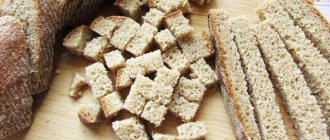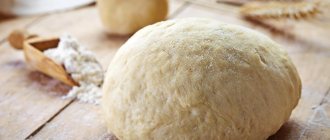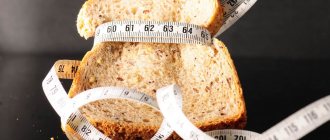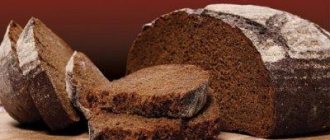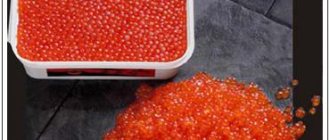White bread, toast
rich in vitamins and minerals such as: vitamin B1 - 27.7%, vitamin B2 - 18.7%, vitamin B9 - 40%, vitamin PP - 19.6%, calcium - 11.9%, phosphorus - 12.9 %, iron - 18.5%, manganese - 21.1%, copper - 13.8%, selenium - 56.4%
- Vitamin B1
is part of the most important enzymes of carbohydrate and energy metabolism, providing the body with energy and plastic substances, as well as the metabolism of branched amino acids. A lack of this vitamin leads to serious disorders of the nervous, digestive and cardiovascular systems. - Vitamin B2
is involved in redox reactions, helps to increase the color sensitivity of the visual analyzer and dark adaptation. Insufficient intake of vitamin B2 is accompanied by impaired condition of the skin, mucous membranes, and impaired light and twilight vision. - Vitamin B9
as a coenzyme is involved in the metabolism of nucleic acids and amino acids. Folate deficiency leads to disruption of the synthesis of nucleic acids and proteins, resulting in inhibition of cell growth and division, especially in rapidly proliferating tissues: bone marrow, intestinal epithelium, etc. Insufficient folate intake during pregnancy is one of the causes of prematurity, malnutrition, and congenital deformities and child development disorders. A strong relationship has been shown between folate and homocysteine levels and the risk of cardiovascular disease. - Vitamin PP
is involved in redox reactions of energy metabolism. Insufficient vitamin intake is accompanied by disruption of the normal condition of the skin, gastrointestinal tract and nervous system. - Calcium
is the main component of our bones, acts as a regulator of the nervous system, and is involved in muscle contraction. Calcium deficiency leads to demineralization of the spine, pelvic bones and lower extremities, increasing the risk of developing osteoporosis. - Phosphorus
takes part in many physiological processes, including energy metabolism, regulates acid-base balance, is part of phospholipids, nucleotides and nucleic acids, and is necessary for the mineralization of bones and teeth. Deficiency leads to anorexia, anemia, and rickets. - Iron
is part of proteins with various functions, including enzymes. Participates in the transport of electrons and oxygen, ensures the occurrence of redox reactions and activation of peroxidation. Insufficient consumption leads to hypochromic anemia, myoglobin deficiency atony of skeletal muscles, increased fatigue, myocardiopathy, and atrophic gastritis. - Manganese
is involved in the formation of bone and connective tissue, and is part of enzymes involved in the metabolism of amino acids, carbohydrates, and catecholamines; necessary for the synthesis of cholesterol and nucleotides. Insufficient consumption is accompanied by slower growth, disturbances in the reproductive system, increased fragility of bone tissue, and disturbances in carbohydrate and lipid metabolism. - Copper
is part of enzymes that have redox activity and are involved in the metabolism of iron, stimulates the absorption of proteins and carbohydrates. Participates in the processes of providing oxygen to the tissues of the human body. Deficiency is manifested by disturbances in the formation of the cardiovascular system and skeleton, and the development of connective tissue dysplasia. - Selenium
is an essential element of the antioxidant defense system of the human body, has an immunomodulatory effect, and is involved in the regulation of the action of thyroid hormones. Deficiency leads to Kashin-Beck disease (osteoarthritis with multiple deformities of the joints, spine and limbs), Keshan disease (endemic myocardiopathy), and hereditary thrombasthenia.
more hide
You can see the complete directory of the most useful products in the application
The benefits and harms of bread from a toaster depend on the amount of product eaten per day. The first devices for toasting bread appeared in the 19th century. They immediately gained wide popularity and are still in demand today. Most lovers of crispy crust do not think about the beneficial properties and dangers of crackers for health, eating toast every day.
How to prepare bread in a toaster
The electrical device operates using hot coils. They emit infrared rays that fry the baked goods. To dry bread in a toaster, do not use additives (oil). Toast is made from just 1 ingredient in a short time.
Cooking method:
- Insert 1 piece of bread into each hole.
- If there is a temperature regulator, set the desired roasting mode. The scale consists of 5 divisions. 1 is a light crust, and 5 is a heavily fried slice.
- Lower the cooking lever.
- Toasts are removed from the appliance after the readiness signal.
Important! During the frying process, you need to make sure that the crackers do not burn in the toaster.
What are the benefits of toaster bread?
The main benefits of toasting bread in a toaster:
- When preparing dried slices, no harmful or high-calorie ingredients are used. Nutritionists recommend eating a couple of pieces of toast a day if you want to lose weight. Especially if a person is not able to give up flour products during the diet.
- Thanks to the toaster, baked goods become less heavy food for the stomach and are beneficial. The gastrointestinal tract spends more energy to digest dry pieces. Accordingly, the processing process involves the calories that were present in the body before entering the toast. Along with fried bread, unnecessary substances also come out of the stomach. Thanks to its cleansing properties, a healthy dry slice is useful for intestinal problems.
- The high content of fiber, molybdenum and vitamin B9 helps restore strength and saturate the body.
Attention! The healthiest way to bake bread from a toaster is to lightly toast a slice.
Is toast good for breakfast?
The beneficial and harmful properties of toast depend on the type of bread. Care should be taken when selecting baked goods for frying in the device. Especially if you plan to eat dry slices for breakfast.
In the morning, the stomach is completely empty, which means it is susceptible to junk food. White bread releases acrylamide when toasted. If such food is abused, the component can accumulate, which leads to the risk of the formation of cancer cells.
Toasting too much creates a buildup of carcinogens on the crust of the toaster slice. It is harmful to consume this product on an empty stomach. To get the most out of your breakfast, it is better to dry the grain product at a minimum temperature.
Is it possible to eat toast while losing weight?
Bread from a toaster contains the same amount of calories as fresh bread. The main rule of all diets is that the amount of carbohydrates consumed should be less than the energy expended. The body needs to use its own resources to maintain a normal state. Then the result in weight loss will be noticeable.
When losing weight, you cannot completely eliminate bread. It contains dietary fiber and fiber essential for health. Nutritionists recommend eating 2-3 pieces of black bread per day. For lovers of crispy baked goods, it is better to use a toaster rather than regular frying in sunflower oil. Then harm to the figure is excluded.
Bread from a toaster for gastritis and pancreatitis
For inflammation of the pancreas, crispy slices will be a godsend. An important condition is to cook the product using a toaster or dry it in the oven. It is not recommended to use oil and spices for patients with pancreatitis. It is better to give preference to black bread. It does not put a strain on the organ and is digested faster than white.
Important! Before introducing toast into a patient’s diet, it is necessary to consult a specialist so as not to cause an exacerbation of the disease.
The main benefit of toasted bread in a toaster for gastritis is the absence of additional components. The patient must adhere to the norms of consumption and use only black bread for cooking. Lightly toasted toast will fill the body with minerals and vitamins.
Making croutons from a loaf
Croutons can be cooked in the oven without oil. To reduce calorie content, it is better to take products made from wholemeal flour so that the crackers are better absorbed by the body.
To prepare, you need to do the following:
- Cut a small amount of product into cubes.
- Mix them with finely chopped herbs - it is better to take dill and parsley.
- Place the product on a baking sheet - you can dry it, you can pre-grease it with oil. In the second case, the nutritional value of the cooked croutons will increase.
- Sprinkle the chopped loaf with spices and salt.
- Place the baking sheet in the oven at 170 degrees for 15 minutes.
- To prevent the loaf or wholemeal product from burning, turn it over periodically.
- Next, remove the crackers from the oven and sprinkle them with water.
- Place the loaf in the oven again for 5-7 minutes.
- Remove the product from the oven and leave it to cool.
Such crackers contain no more than 330 kcal per 100 g. They are recommended to be added to soups and other dishes.
What kind of bread to use for the toaster
To make toast, any type of bread is suitable. You can even use buns. The choice depends entirely on taste preferences. It is worth considering the presence of chronic diseases and contraindications in order to obtain only beneficial properties from the product.
Important! Fresh wheat bread is fried quickly, unlike rye bread. It is important to choose the right temperature setting in the toaster so that the slices do not burn.
The slices should be cut with a special knife. They should not exceed 2 cm in thickness. If you don’t get perfect pieces, you can purchase already cut products in the store.
How much toasted bread can you eat per day?
Children under 2 years of age are prohibited from eating slices. The product is difficult to digest and can be harmful. The children's body does not have enough enzyme properties for digestion. A child aged 3 years is allowed to eat 60 g of crackers per day.
Which is healthier: fresh bread or toast?
The properties and benefits of toast directly depend on the type of bakery product used for preparation. Fans of toaster crackers are wary of eating fresh bread. It has the property of triggering fermentation in the stomach, and its particles also settle in the digestive tract.
The danger of fresh baked goods is gaining excessive weight when consuming it. It is important to realize that toast is made from a primary product, which means it does not have more beneficial properties than the original raw material.
The bread product is saturated with B vitamins. With their help, it is easier for the body to fight elements that cause harm. The benefits of a product cooked in a toaster are high; it is able to absorb negative substances.
What can you eat bread from a toaster with?
To make French toast, you need to soak the bread in the pre-made mixture. You need to mix eggs, milk, orange zest and add a little cinnamon. The pieces are then fried until golden brown and flavored with powdered sugar.
A regular chicken egg would be a wonderful addition to toast. Gourmets often prefer toast with a poached egg. It is necessary to cover the cup with cling film and break the egg into the container without damaging the yolk. After seasoning a little with salt, you need to tighten the film into a bag and cook in a saucepan for about 5 minutes.
A sweet version of crackers is often prepared with the addition of honey or jam. An excellent alternative to jam is ready-made berry syrup. You can use caramel or a small amount of chocolate spread.
Toast with various berries will be useful for children. Fresh strawberries, blueberries, cherries and more will work well. The surface of the finished toast is flavored with butter or honey. Cottage cheese is suitable for children for greater benefit.
Is bread from a toaster harmful?
When bread is turned into toast, the moisture evaporates, but the calories remain the same. When a product is cooked in a toaster, a reaction occurs between amino acids and carbohydrates, which leads to the formation of acrylamides. This substance is harmful. It can trigger the process of proliferation of cancer cells. It is important to note that the percentage of acrylamide in toast is very small. The harm will be minimal if you do not overuse the amount of crackers.
To prepare this delicacy correctly and healthily, you do not need to use white bread. Burnt pieces should be removed. Fried parts of toast are especially harmful.
The benefits of white bread
The following benefits of white bread have been proven:
- the product is rich in vitamins B and PP, which are necessary to maintain a healthy nervous system, skin, heart and blood vessels;
- the minerals of bread (calcium and phosphorus) are indispensable for the health of nails, teeth and the skeletal system of the body;
- Iron in white bread regulates the concentration of hemoglobin in the blood, which ensures oxygen transport. Thus, this product is indicated for the prevention of anemia;
- White bread is characterized by a high glycemic index, so it quickly increases the level of glucose in the blood, saturating the body with strength and energy. Such flour products are recommended to be included in the diet during active sports and heavy physical activity.
Benefit
It should be remembered that not all flour is equally harmful. For example, unsweetened baked goods made from wholemeal flour are a source of fiber that is beneficial for the digestive system. But you always need to know when to stop. After all, the abuse of even healthy products can cause significant harm.
- Bran and rye are a source of carbohydrates with a low glycemic index. These are healthy carbohydrates that provide a long-lasting feeling of satiety and stimulate brain activity.
- White is rich in protein, iron, phosphorus and potassium.
- Eating black has a positive effect on the functioning of the nervous system, prevents fatigue, and improves the condition of the skin, hair and nails.
- Allows you to remove toxins, heavy metal salts and radionuclides.
- By eating bran or rye bread, you will significantly reduce the total number of calories you consume, as you will feel full much faster and eat less. You should completely avoid confectionery products and sugar (the combination, beloved by many, with honey or jam is prohibited). In addition, the calorie content of bread is much lower than, for example, shortbread or chocolate. Eat it with pieces of lean meat and fresh vegetables. For example, 25 g of bran bread + 20 g of boiled chicken meat + cucumber is an ideal snack between breakfast and lunch.
The benefits of bread product
Having considered the energy value of various types of baked goods, it is necessary to present its benefits so that readers can decide whether to consume it daily. The benefits of the product are indicated by the composition presented in the table.
| VITAMINS | CONTENTS, MG | MINERALS | CONTENTS, MG |
| Kholin | 60 | Chlorine | 680 |
| Vitamin E | 2,3 | Sodium | 400 |
| Vitamin B3 | 2 | Potassium | 244 |
| Vitamin B5 | 0,55 | Phosphorus | 194 |
| Vitamin B6 | 0,2 | Magnesium | 57 |
| Vitamin B2 | 0,09 | Sulfur | 56 |
| Vitamin B9 | 0,03 | Calcium | 33 |
| Vitamin B1 | 0,02 | Silicon | 5,5 |
| Vitamin A | 0,003 | Iron | 4,5 |
| Vitamin H | 0,002 | Zinc | 1 |
The benefits of bread lie in the content of healthy amino acids, complex carbohydrates and fiber. The substances presented can normalize intestinal function and reduce cholesterol levels in human blood.
But the consumption of baked goods should be in moderation, because otherwise you may encounter increased intestinal gas formation. This in most cases occurs when consuming large quantities of wheat or products with bran.
| Name | Calorie content per 100 g |
| Wheat flour loaf | 235 kcal |
| Pancake flour (pancake flour) | 333 kcal |
| Pancake with cottage cheese | 162 kcal |
| Pancake with mushrooms | 200 kcal |
| Pancake with meat | 186 kcal |
| Pancake with chicken and rice | 169 kcal |
| Butter bun | 300 kcal |
| Hot dog bun | 266 kcal |
| Burekasi with cabbage | 393 kcal |
| Burekas with liver | 404 kcal |
| Burekas with jam | 412 kcal |
| Burekas with meat | 373 kcal |
| Burekasi with onion and egg | 354 kcal |
| Croissant with caramel | 298 kcal |
| Croissant with cabbage | 377 kcal |
| Coffee croissant | 346 kcal |
| Wheat flour | 334 kcal |
| Rye bran | 212 kcal |
| Wheat bran | 260 kcal |
| Blueberry pie (pie with blueberries) | 196 kcal |
| Strawberry pie (pie with strawberries) | 221 kcal |
| Pie with lingonberries | 242 kcal |
| Fried pie with liver | 336 kcal |
| Pie fried with onion and egg | 248 kcal |
| Pie with cabbage | 246 kcal |
| Pie with fish | 227 kcal |
| Pie in Ural style | 178 kcal |
| Drying | 341 kcal |
| Cream crackers | 398 kcal |
| Rye crackers (Finnish) | 320 kcal |
| Wheat-oat crackers (well done bread) | 295 kcal |
| Wheat-buckwheat crackers (well done bread) | 280 kcal |
| Puff pastry without yeast | 487 kcal |
| Crackers with cranberries (Doctor Korner) | 330 kcal |
| Cereal crackers (Doctor Korner) | 312 kcal |
| Black bread | 214 kcal |
| White wheat bread | 223 kcal |
| Borodino bread | 208 kcal |
| Chusovsky dark bread | 212 kcal |
| Malt bread | 281 kcal |
| Kaiser bread | 271 kcal |
| Corn bread with seeds | 290 kcal |
| Rye bread made from peeled flour | 189 kcal |
| Rye bread made from wallpaper flour | 181 kcal |
Harm
Store-bought bread made from premium wheat flour has virtually no beneficial properties for the body. The fact is that in the process of producing such flour, “ballast substances” are removed from cereals - the flower shell (bran), the grain germ (a source of vitamin E) and the aleurone layer of the grain (a source of protein valuable for the body). Then it is bleached so that baked goods from it have an attractive appearance. The result is refined flour with a high starch content, which contributes to the appearance of extra pounds. In addition, factory-made bread made from such flour contains various nutritional additives. These are preservatives (for example, sorbic acid), flavorings, emulsifiers and disintegrants. It is likely that you will eat a lot of this bread, but since it contains harmful carbohydrates with a high glycemic index, you will not feel full. And this is a direct path to extra pounds.
Another point is yeast. Yeast fungi disrupt the intestinal microflora, which impairs digestion and provokes putrefactive processes. In addition, they interfere with the absorption of vitamins and microelements necessary for the body. Under such conditions, toxins accumulate that can provoke many serious diseases (gastritis, seborrhea, gallstones).
When choosing bread in the store, be sure to pay attention to its composition. If you watch your diet and care about the health of your family, make a choice in favor of natural foods.
How much does a piece of bread weigh?
In order to accurately determine the weight of the piece you cut, you can use a kitchen scale. You can use a simpler method of calculation. For example, a loaf of “Borodinsky” weighs 350 g. If you cut it into 10 parts, you will get 10 slices of 35 g each, if you cut it into 20, the weight of each piece will be 17.5 g. Before cutting, conditionally divide the loaf into equal parts. A piece of bread 1.5 cm thick weighs 25-30 g.
Dietary properties:
How many calories are in white bread, what dietary properties it has, all this is very interesting for those who are trying to lead a healthy lifestyle, monitor their health and figure. So we will try to answer these questions in the next article.

White bread is made from premium, first or second grade wheat flour. It makes great toast or sandwiches, or you can use it to prepare other dishes. But white bread has a fairly high nutritional value.
Therefore, it definitely cannot be classified as a dietary product. This should be remembered by those who want to lose weight.
White bread is a source of a number of vitamins - vitamins B1, B2 and PP, without which normal functioning of the body is impossible.
Vitamin B1 (thiamine) is needed for the functioning of our nervous system. If there is enough of it, the person is in a good mood and not irritable. Vitamin B2 (riboflavin) is essential for youthful skin, its smoothness and elasticity. And our brain and cardiovascular system need vitamin PP.
Energy value
To get rid of excess weight and stay in good physical shape, you don’t have to go on a diet with a meager diet. It is enough to monitor the number of calories consumed and expended. Do not give up bread if without it your nutrition will seem incomplete and every meal will seem incomplete. After all, this can provoke psychological discomfort, which will negatively affect health. You just need to determine the optimal amount of calories and follow this norm.
Calorie content of varieties
Now let's talk about the calorie content of different varieties.
White
100 g of white bread contains 8.12 g of protein, 2.11 g of fat and 50.19 g of carbohydrates. For example, the calorie content of a loaf is 260 kcal per 100 g. 100 g of a baguette contains 262 kcal, and a white wheat baguette with longitudinal cuts contains 242 kcal per 100 g.
Grey
Contains both rye and wheat flour in different proportions. Nutritional value: 9.40 g of proteins, 2.79 g of fat and 49.25 g of carbohydrates per 100 g. Calorie content - 262 kcal per 100 g. In rye-wheat “Darnitsky” bread 206 kcal per 100 g, in “Ukrainian” - 198 kcal.
Black
Black contains a full set of amino acids essential for the body. Among them is lysine, which is necessary for the absorption of proteins, full metabolism and the production of antibodies of the immune system. Consumption of bread made from rye flour promotes the rapid removal of carcinogens and metabolic products from the body. However, use is not recommended for high acidity, gastritis and ulcers. 100 g of rye bread without additives contains 6.90 g of protein, 1.30 g of fat and 40.9 g of carbohydrates. The calorie content of black Borodinsky is 202 kcal.
"8 grains"
The composition includes eight types of flour from eight grains. It contains vitamins (B1, B2, B5, B6, B9, B12, E) and useful substances such as magnesium, calcium, potassium, zinc, phosphorus, iodine, iron and sodium. Calorie content of 8-grain bread is 269 kcal per 100 g. Nutritional value is 13.7 g of protein, 5.2 g of fat and 42 g of carbohydrates.
With bran
Bran contains vitamins B1, B6, B12, E, PP, zinc, iron and phosphorus. Its consumption has a positive effect on the functioning of the digestive, cardiovascular and nervous systems. Bran is an effective adsorbent. They help eliminate toxins and reduce cholesterol levels in the blood. The energy value of bread with bran is 227 kcal per 100 g. Nutritional value is 7.5 g of proteins, 1.3 g of fat and 45.2 g of carbohydrates per 100 g of product.
Grain
The cereal contains whole cereal grains. Therefore, almost all vitamins (B, A, E, PP) and microelements (potassium, sodium, molybdenum, phosphorus, iodine, iron, calcium) that are present in the grain shell are preserved in it. Due to the high content of dietary fiber, food consumption has a beneficial effect on the activity of the gastrointestinal tract. Regular consumption prevents the development of atherosclerotic changes in blood vessels and is a prevention of diabetes mellitus. The calorie content of grain bread, depending on the variety, is 220 - 250 kcal per 100 g of product.
Yeast-free
Due to the fact that the cooking principle excludes the use of baker's yeast, it is considered the most healthy and, moreover, the lowest in calories. Its consumption is a prevention of diseases of the gastrointestinal tract, as it helps to normalize metabolic and digestive processes. There are many types of yeast-free bread. You can find it on the supermarket shelf or prepare it yourself. In this case, the calorie content will depend on the ingredients used. The calorie content of yeast-free bread is 150 - 180 kcal per 100 g. If you cook it yourself and add, for example, sesame seeds or seeds, the energy value will be higher.
Toast
Bread intended for toasting is slightly sweeter than regular white bread and has a higher calorie content. Per 100 g of product - 290 kcal. Nutritional value: 7.3 g protein, 3.9 g fat and 52.5 g carbohydrates. Due to frying in a toaster, the mass of the piece changes slightly (due to loss of moisture), but not its calorie content. So, the calorie content of toast weighing 15 g will be 40 - 45 calories, toast made from black bread - about 200 calories per 100 g, or 30 for one piece of toast weighing 15 g.
Corn
Corn contains a large amount of fiber, which prevents the absorption of excess cholesterol and protects the cardiovascular system. Vitamins (A, B1, B2, C) and mineral components (sodium, potassium, calcium, magnesium, phosphorus), which are part of corn flour, normalize metabolic processes. It is useful for mild forms of diabetes, diseases of the pancreas and intestines. Nutritional value – 6.70 g of protein, 7.10 g of fat and 43.50 g of carbohydrates per 100 g of product. Calorie content – 266 calories.
Fruit
Dates, dried apricots, raisins, figs, oranges, nuts, etc. are added to this one. To prepare fruit, rye flour is traditionally used. This product is suitable for snacking between main meals. 100 g contains 7.80 g of protein, 7.75 g of fat and 53.80 g of carbohydrates. Calorie content of fruit bread is 325 kcal. When preparing yourself, consider the calorie content of the ingredients used.
Dried
Dried bread is healthier for the digestive tract because it is much less sticky than fresh bread. In addition, crackers are an excellent addition to hot liquid dishes. The calorie content of dried and fresh bread does not differ, since the drying process - both natural and in the oven - occurs without adding any additional ingredients. Thus, the calorie content of 100 g of white bread crackers is 260 - 330 calories per 100 g, gray bread crackers are 200 - 270 calories per 100 g, rye crackers are 170 - 220 calories per 100 g.
Fried
The calorie content of fried bread depends, firstly, on what kind of bread and how much you use. And secondly, it depends on what you fry it on. For example, if you fry a slice of wheat bread (weighing 30 g - 72 calories) in butter (3 g - 23 calories), its calorie content will be 105 calories. Good option for breakfast.
With butter
To determine the calorie content of a sandwich with butter, you need to know the exact amount of ingredients, as well as their energy value. For example, a piece of “Borodinsky” bread weighing 25 g is 52 calories, 4 g of butter is about 30 (be sure to check the calorie content on the package). That is, the calorie content of rye bread with butter in such proportions will be 82 calories.
Toast calorie content per 100 grams
There are relatively harmless things here, like black bread, which is savory and filling and you can’t eat too much of it (although hot soft Darnitsky with a fragrant crust. yes with fresh curd cheese. yes with olives. ahem! Stop, I think I got distracted) . But there are also the most insidious things like butter buns or pies: they are filling, but they are so tasty that the feeling of fullness does not stop you from having another, and another, and another bun with a cup of hot tea. Only three buns - and in terms of calories it turns out to be a full meal, which, if it consisted of meat, would satisfy even a Stakhanovite lumberjack.
But for example, with drying, the situation is exactly the opposite: the calorie content per 100 g seems to be high, but the product is dry, and a lot of things fit into these 100 g. When used sparingly, 30-50 g of unsweetened baby sushi can be stretched into several cups of tea - this is a real salvation for those who cannot drink empty tea and are on a diet. And 30 g of buns is just ridiculous, it’s only a fifth of some bun.
Calorie content of rye-wheat bread - 210 kcal
The piece of bread in the picture weighs 22 g. This is the most common bread in the middle zone, which is available in any bakery and any canteen. The piece of bread in the photo is also the most ordinary one, about a centimeter thick.
The calorie content of this piece in the photo is 46 kcal.
Two slices of black bread are enough for 100 kcal.
The calorie content of this cookie is 463 kcal.
The three cookies in the picture together weigh 54 g. These are the most ordinary cookies, in size they are even closer to small ones than to large ones. There's not much chocolate in them.
The calorie content of the cookies in the picture is 250 kcal.
For 100 kcal, you can eat 1 cookie and take a bite of the second one.
The calorie content of crackers with sugar is 413 kcal.
The crackers in the picture weigh 60 g, 20 g per cracker. These are quite fresh, not quite hard crackers; if they were completely dry, they would weigh less.
The calorie content of the crackers in the picture is 250 kcal.
For 100 kcal you can eat 1 cracker and another small piece.
The calorie content of poppy seed cakes is 378 kcal.
The five dryers in the picture are 20g, 4g per dryer. These are very small, dry to the point of hardness, unsweetened drying.
The calorie content of the dryers in the picture is 75 kcal.
For 100 kcal you can eat 6 sushi.
The calorie content of toast bread is 258 kcal.
The toast in the picture is 15 g. Toast bread is a little richer and sweeter than plain white bread. The cut is standard for toast, I didn’t cut it, it was already sold that way. These pieces are less than a centimeter thick, light to the point of weightlessness. If your pieces look solid, it means they don’t contain 15 g.
The calorie content of the toast in the picture is 38 kcal.
For 100 kcal you can eat two to two and a half pieces.
The calorie content of the bread did not change after being in the toaster. But the weight of the piece has changed, which has shrunk and now weighs 11 g. Thus, the number of calories per 100 g has increased, but the piece still contains 38 kcal and remains the same. But don’t deceive yourself and weigh your toast AFTER toasting - naturally, it will weigh less, only the calorie content on the package is indicated for the bread in the package.
Article rating:
Toast calorie content per 100 gramsLink to main publication
Related publications
- GTO standards 2021 table of standards 12 years
How to eat properly
- Try not to eat bread while it is hot, as the increased stickiness will make it very difficult to digest. This can cause exacerbation of gastritis, upset, or constipation. If you suffer from diseases of the gastrointestinal tract, eat it slightly dried. It has less of a juice effect (this is dangerous with high acidity) compared to fresh.
- Combination with potatoes is not recommended at all, as these products have a high starch content.
- It is better to eat black with meat, fish, cottage cheese and butter.
- Pairs well with fresh vegetables.
- Don't eat moldy bread. The fact is that mold contains more than a hundred toxic compounds that can cause serious illnesses, including cancer. Therefore, it is better to throw away any moldy products immediately.
- To avoid gaining weight, eat no more than 100 g of rye and rye-wheat bread per day. White - no more than 80 g per day.
Who benefits from white bread?
First of all, bread is a simple carbohydrate, as it contains wheat flour. This product is easily absorbed by the body. Undoubtedly, the product will bring nothing to an inactive person except fat deposits. But for athletes the product is indispensable. Its essence is that the body reacts to the intake of the product by producing insulin, reducing the concentration of sugar in the blood. This slows down muscle breakdown and stimulates muscle growth after exercise.

Baked goods are the easiest way to have a quick snack after a heavy workout. At this time, the body spends energy on muscle restoration and does not convert carbohydrates into subcutaneous fat. Therefore, it is difficult to call bread a useless product. It is especially useful for children, because the growing body absorbs the product more easily, unlike coarsely ground varieties, and uses it to build new tissues. It is worth remembering the hospital diet table, which always contains a piece of white baked goods with butter.
Video
Toast in the morning is just wonderful. They can be eaten with honey or jam, or even with bacon. But it’s logical to ask yourself the question: are they good for health? We tried to understand this issue and are happy to share the information with you.
Toast is toasted and well-baked bread, which is practically no different from ordinary fresh bread. Their nutritional value is the same. In this case, the type of bread (white, black or rye) does not play any role.
Toast is as healthy or unhealthy as regular bread. However, during the toasting process, the moisture contained in the composition evaporates, so the toast becomes lighter, but does not change in size. Also, during the cooking process, a reaction occurs on the surface of the bread, and thanks to it the crust turns brown. There's nothing wrong with that. If we summarize the reaction process, it looks like this: during baking, amino acids, sugar and carbohydrates - the components of protein - react with each other. It is thanks to this reaction that the taste and color of bread undergo changes. As for the composition, it changes slightly.
Calories in toast
The number of calories does not change when toasting. That is, if you put 100 kcal in the toaster, then after roasting you will get almost 100 kcal. Therefore, attempts to change the kcal content of toast are pointless. Some amount on the surface of the bread is indeed lost, but it is too small to even give its value, but still: in a piece of ordinary bread - 70 calories; in a baked piece – 69.5.
The question of the benefits and harms of a toaster becomes relevant when it comes to acrylamides. It is a reaction product between carbohydrates and amino acids. This reaction occurs when bread is toasted. Scientists come to the conclusion that acrylamide is harmful because it promotes the development of cancer cells, but the content of this substance in toast is so small that there is no need to talk about harm. A person would need to eat several tons of toast to at least expose their body to the risk of developing cancer cells (well, that's too general).
How many calories are in white bread?
The calorie content of white bread, per 100 grams, is:
Proteins, fats and carbohydrates (BJU) of white bread in gr. per 100 grams:
Calorie content of white bread croutons, per 100 grams, is:
Proteins, fats and carbohydrates (BJU) in gr. per 100 grams:
If the following products were used to prepare this dish:
- Bread - 200 g - (532 kcal)
- Vegetable oil - 2 tbsp. — (288 kcal)
Calorie content of white bread toast, per 100 grams, is:
Proteins, fats and carbohydrates (BJU) in gr. per 100 grams:
The calorie content of homemade white bread, per 100 grams, is:
Proteins, fats and carbohydrates (BJU) in gr. per 100 grams:
If the following products were used for baking:
- Flour - 1000 g - (3420 kcal)
- Sugar - 1 tbsp. — (77 kcal)
- Vegetable oil 3 tbsp. — (432 kcal)
- Yeast - 50 g - (37 kcal)
- Water - 500 ml. — ()
Great video with a great recipe. Worth a look!
And further:
This type of bread contains calcium, phosphorus, and iron. It will hardly come as a surprise to anyone to learn that calcium and phosphorus are the basis for the strength of teeth, bones and nails. It’s not for nothing that children are given products containing these components from an early age. And iron is important for the normal content of hemoglobin in the blood, which is responsible for the transport of oxygen throughout the body. A small amount of hemoglobin is a painful condition - anemia and hypoxia.
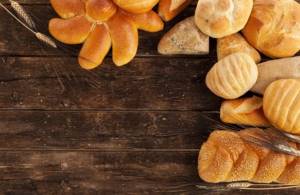
Almost any diet involves giving up all flour products. For this reason, there is a very common stereotype that bread is the enemy of slimness. This is only partly true. After all, different varieties can bring both harm and benefit to the body. If you find it difficult to give up consuming bread, you don’t have to do it at all. You just need to figure out which type is healthy and in what quantity you can eat it without damaging your figure.
Correct usage
To eliminate possible harm and add benefits to the toast being prepared, you must, at a minimum, use non-white bread.
Use whole grain bread (and in general, white bread is not healthy even in its normal state). If the bread is slightly burnt, be sure to cut off these pieces. Burnt toast certainly won't be healthy. The healthiest pieces of bread are the ones that are least toasted, so when cooking on the thermostat, set either less cooking time or the lowest level of doneness. Please rate the article:
